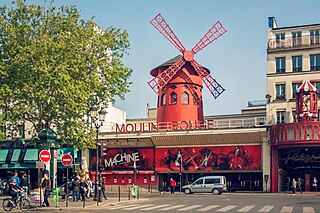
Moulin Rouge is a cabaret in Paris, on Boulevard de Clichy, at Place Blanche, the intersection of, and terminus of Rue Blanche.

Montmartre is a large hill in Paris's northern 18th arrondissement. It is 130 m (430 ft) high and gives its name to the surrounding district, part of the Right Bank. Montmartre is primarily known for its artistic history, for the white-domed Basilica of the Sacré-Cœur on its summit, and as a nightclub district.

Comte Henri Marie Raymond de Toulouse-Lautrec-Monfa, known as Toulouse Lautrec, was a French painter, printmaker, draughtsman, caricaturist, and illustrator whose immersion in the colourful and theatrical life of Paris in the late 19th century allowed him to produce a collection of enticing, elegant, and provocative images of the sometimes decadent affairs of those times.
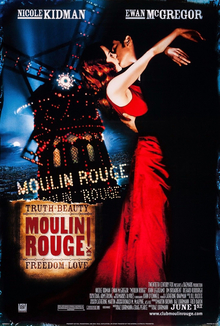
Moulin Rouge! is a 2001 jukebox musical romantic drama film directed, produced, and co-written by Baz Luhrmann. It follows an English poet, Christian, who falls in love with the star of the Moulin Rouge, cabaret actress and courtesan, Satine. The film uses the musical setting of the Montmartre Quarter of Paris and is the final part of Luhrmann's "Red Curtain Trilogy", following Strictly Ballroom (1992) and Romeo + Juliet (1996). A co-production of Australia and the United States, it features an ensemble cast starring Nicole Kidman and Ewan McGregor, with Jim Broadbent, John Leguizamo, Richard Roxburgh, Jacek Koman, and Caroline O'Connor in supporting roles.

Suzanne Valadon was a French painter who was born Marie-Clémentine Valadon at Bessines-sur-Gartempe, Haute-Vienne, France. In 1894, Valadon became the first woman painter admitted to the Société Nationale des Beaux-Arts. She was also the mother of painter Maurice Utrillo.

Moulin Rouge is a 1952 British historical romantic drama film directed by John Huston from a screenplay he co-wrote with Anthony Veiller, based on the 1950 novel of the same name by Pierre La Mure, and produced by John and James Woolf. The film follows artist Henri de Toulouse-Lautrec in 19th-century Paris's bohemian subculture in and around the Moulin Rouge, a burlesque palace. The film was screened at the 14th Venice International Film Festival, where it won the Silver Lion.
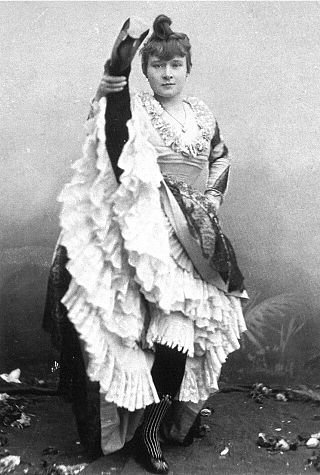
La Goulue, was the stage name of Louise Weber, a French can-can dancer who was a star of the Moulin Rouge, a popular cabaret in the Pigalle district of Paris, near Montmartre. Weber became known as La Goulue because as an adolescent, she was known for guzzling cabaret patrons' drinks while dancing. She also was referred to as the Queen of Montmartre.

Jane Avril was a French can-can dancer made famous by Henri de Toulouse-Lautrec through his paintings. Extremely thin, "given to jerky movements and sudden contortions", she was nicknamed La Mélinite, after an explosive.
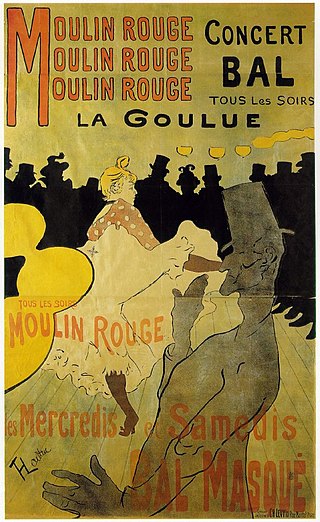
Valentin le Désossé was the stage name of Jacques Renaudin, a French can-can dancer who was a star of the Moulin Rouge in the 1890s as the partner of Louise Weber, known as La Goulue.

The Musée de Montmartre is located in Montmartre, at 8-14 rue Cortot in the 18th (XVIII) arrondissement of Paris, France. It was founded in 1960 and was classified as a Musée de France in 2003. The buildings were formerly the home of several famous artists, including Pierre-Auguste Renoir and Suzanne Valadon.

Le Moulin de la Galette is the title of several paintings made by Vincent van Gogh in 1886 of a windmill, the Moulin de la Galette, which was near Van Gogh and his brother Theo's apartment in Montmartre. The owners of the windmill maximized the view on the butte overlooking Paris, creating a terrace for viewing and a dance hall for entertainment.

The Montmartre paintings are a group of works that Vincent van Gogh created in 1886 and 1887 of the Paris district of Montmartre while living there, at 54 Rue Lepic, with his brother Theo. Rather than capture urban settings in Paris, van Gogh preferred pastoral scenes, such as Montmartre and Asnières in the northwest suburbs. Of the two years in Paris, the work from 1886 often has the dark, somber tones of his early works from the Netherlands and Brussels. By the spring of 1887, van Gogh embraced use of color and light and created his own brushstroke techniques based upon Impressionism and Pointillism. The works in the series provide examples of his work during that period of time and the progression he made as an artist.

William Tom Warrener was an English painter of portraits, landscapes and figurative subjects. He is best known for being the subject of his friend Henri de Toulouse-Lautrec's painting L'Anglais au Moulin Rouge (1892). He also appears in the background of Jane Avril dansant (1892).

Moulin Rouge: La Goulue is a poster by French artist Henri de Toulouse-Lautrec. It is a colour lithograph from 1891, probably printed in about 3,000 copies, advertising the famous dancers La Goulue and "No-Bones" Valentin, and the new Paris dance hall Moulin Rouge. Although most examples were pasted as advertising posters and lost, surviving examples are in the collection of the Indianapolis Museum of Art and many other institutions.
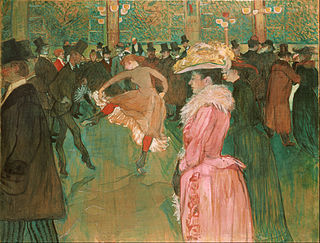
At the Moulin Rouge, the Dance is an oil-on-canvas painted by French artist Henri de Toulouse-Lautrec. It was painted in 1890, and is the second of a number of graphic paintings by Toulouse-Lautrec depicting the Moulin Rouge cabaret built in Paris in 1889. It portrays two dancers dancing the can-can in the middle of the crowded dance hall. A recently discovered inscription by Toulouse-Lautrec on the back of the painting reads: "The instruction of the new ones by Valentine the Boneless." This means that the man to the left of the woman dancing, is Valentin le désossé, a well-known dancer at the Moulin Rouge, and he is teaching the newest addition to the cabaret. To the right, is a mysterious aristocratic woman in pink. The background also features many aristocratic people such as poet Edward Yeats, the club owner and even Toulouse-Lautrec's father. The work is currently displayed at the Philadelphia Museum of Art.

Cha-U-Kao was a French entertainer who performed at the Moulin Rouge and the Nouveau Cirque in the 1890s. Her stage name was also the name of a boisterous popular dance, similar to the can-can, which came from the French words "chahut", meaning "noise" and "chaos". She was depicted in a series of paintings by Henri de Toulouse-Lautrec. Cha-U-Kao soon became one of his favorite models. The artist was fascinated by this woman who dared to choose the classic male profession of clowning and was not afraid to openly declare that she was a lesbian.
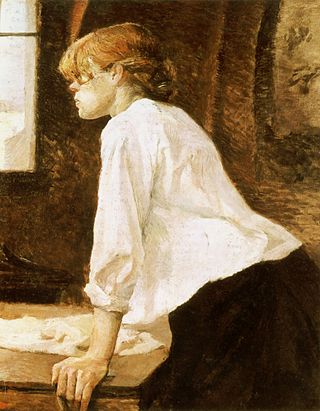
La Blanchisseuse is an 1886 oil-on-canvas painting by French artist Henri de Toulouse-Lautrec. In November 2005, it was sold for 22.4 million dollars at auction by Christie's. The subject of laundresses, also known as washerwomen, was a popular one in art, especially in France.

Au Lapin Agile is a 1905 oil on canvas painting by Pablo Picasso. It depicts the interior of the Lapin Agile, a famous cabaret club in the Montmartre area of Paris. The composition was produced during Picasso's Rose Period and includes a self-portrait of the artist who frequented the club in his youth. The painting is listed as one of the most expensive paintings after achieving a price of $40.7 million at Sotheby's auction on 27 November 1989. It is housed in the collection of the Metropolitan Museum of Art in New York City.

La Toilette, also known as Rousse, is an painting by Henri de Toulouse-Lautrec, from 1889. The painting depicts a red-headed woman, stripped to the waist, seated on the floor, facing away from the viewer, just before or just after bathing. Held by public collections in France since 1914, it has been at the Musée d'Orsay, in Paris, since 1983.

The Englishman at the Moulin Rouge is a late-19th-century painting by French artist Henri de Toulouse-Lautrec. Done in oil on cardboard, the work depicts British artist William T. Warrener – a close friend of Lautrec – and two women at the Moulin Rouge cabaret in Paris. The painting served as a preparatory study for a color lithograph of 1892, and is in the collection of the Metropolitan Museum of Art, which acquired it in 1967.



















